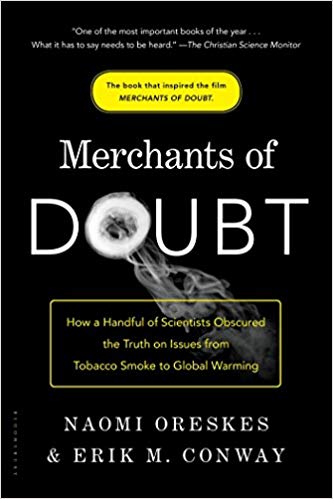Naomi Oreskes & Erik Conway
Bloomsbury Press
New York, NY
2011
355 pages
According to the Art:
This book is an exposé of the vulnerability that exists in advanced, western, democratic societies to trumped up arguments that can topple scientific evidence revealing urgent needs of individuals, societies, and nations, and can frustrate their solutions.
Synopsis:
Naomi Oreskes and Erik Conway examine the successful efforts of a few scientists to jam the spokes in the wheel of science, delaying needed mitigations (e.g., regulations) to protect individuals, vulnerable populations, nations, and the earth.
The authors chose the well-known and controversial debates around second hand tobacco smoke, acid rain, the strategic defense initiative, the ozone hole, global warming, and the pesticide DDT as the substrate for their investigation. Each issue involves a large accumulation of evidence of the dangers it presents to humans. And each provoked skepticism and opposition from related industries, contrarian scientists, and anti-regulation politicians and institutes. Industry opposes regulations that could threaten their businesses. Free market ideologists do not want regulations that could threaten capitalism and accelerate a slide into socialism.
Faced with mounting scientific evidence and general agreement amongst credible researchers, those whose interests were threatened needed a strategy to win that didn’t rely on scientific evidence. The tobacco industry led the way by hiring “a public relations firm to challenge the scientific evidence that smoking could kill you,” (p. 15) and to ensure that “scientific doubts must remain.” (p. 16) The authors drew from publicly available documents to best convey this idea:
‘Doubt is our product,’ ran the infamous memo written by one tobacco industry executive in 1969, ‘since it is the best means of competing with the ‘body of fact’ that exists in the minds of the general public.’
p. 34
The industry realized, however, that renowned scientists would be needed “to merchandize doubt,” (p. 33) and so they recruited some. First among them was Frederick Seitz. He was a physicist who had been involved in the atomic bomb program during World War II and later in Cold War weapons programs. He knew next to nothing about the science showing the harm of tobacco smoke. However, his time as president of the National Academy of Sciences and as president of Rockefeller University accorded him credibility on all matters of science, at least to constituencies outside of science. His attacks on the science showing the harms of tobacco smoke had a lot to do with the decades it took before governments and the public took meaningful actions.
This became the approach opponents took against of science-based initiatives they wanted to scuttle. Seitz was recruited for other campaigns, but so were other physicists with similar backgrounds to form what Oreskes and Conway call a “small network of doubt mongers.” (p. 213) They make a point that this network only threw darts—poisonous darts—at the science they targeted and never once contributed their own original research to support their opposition to any scientific findings or consensus.
Oreskes and Conway tie the motives of these scientists primarily to their fierce devotion to liberty, which then meant fighting Communism and any other forms of socialism. They suggest that some degree of curmudgeonry and contrarianism is involved as well, but they focus more on political ideologies as the primary drivers for these people:
…they were working to ‘secure the blessings of liberty’…if science was being used against those blessings—in ways that challenged the freedom of free enterprise—then they would fight it as they would fight any enemy. For indeed, science was starting to show that certain kinds of liberties are not sustainable—like the liberty to pollute.”
pp. 238-239
The authors hold the news media responsible for much of what the doubt mongers accomplished, specifically faulting them for applying the “fairness doctrine”—each side of an argument will get equal time—to the point of absurdity.
…it especially does not make sense to dismiss the consensus of experts if the dissenter is superannuated, disgruntled, a habitual contrarian, or in the pay of a group with an obvious ideological agenda or vested political or economic interest. Or in some cases, all of the above.
pp. 272-273
The news media, they assert, are the gatekeepers and should be able to distinguish charlatans and snake oil salesmen from legitimate scientists. In this role, they failed as far at the authors are concerned. There can be no network of doubt mongers without a news media that either can’t or won’t call them out.
In contrast, the authors give the scientists who didn’t call out the doubt mongers a more forgiving critique. For the most part, they say, scientists facing a fight will retreat to their labs and concentrate on their work—they’re discoverers, not fighters. On them, “intimidation works.” (p. 265)
Analysis:
This book is an exposé. But it’s not an exposé just about how a small group of scientists can upend mountains of scientific evidence and a broad consensus among credible scientists on a given issue. The book is also an exposé of the vulnerability that exists in advanced, western, democratic societies to trumped up arguments that can topple scientific evidence revealing urgent needs of individuals, societies, and nations, and can frustrate their solutions. In addition to exposing rogue scientists and the reasons for their attacks, Oreskes and Conway are also exposing the failure of news media to hold them accountable, and the impugned scientists to take them on.
The vulnerability of serious and credible scientists to doubt when it’s used as a weapon against them derives from the very nature of the scientific method that is in place now and has been for centuries which only rarely produces findings that reveal incontestable truth. The majority of the time it produces probabilities that a particular finding reveals the truth. Scientists know this, they adapt to it, and they generate inferences and conclusions accordingly—and change them when the facts change. The doubt mongers know this too. They feast on people unable to apply critical analysis to uncertainty, and exploit those who do, but who will not fight back.
The authors provide a thorough if overly detailed report. They don’t offer much in the way of solutions, but they didn’t promise any. They chide the news media to become more effective in their role as the Fourth Estate where it concerns science. As for what can be expected of scientists, Oreskes and Conway have little hope that as a group they would fight back. They’re off the hook.
Indeed, they throw up their hands and reference de Tocqueville in saying that “we are all left…with nothing but confused clamor.” (p. 274) But, then they make a glancing gesture at C.P. Snow, who in 1959 famously characterized the sciences and the arts as two distinct cultures. In making this distinction, he hoped that the constituents of these cultures could draw on each other’s unique knowledge domains to enhance their own. Alas, Oreskes and Conway’s mention of Snow had to do only with his worries about cynicism. This was a missed opportunity. If they could not depend on the sciences to defend their evidence and consensuses, then they might have built on Snow’s ideas about bringing other disciplines with foundations in critical thinking into the fray to train scientists, news media, and the broader population. Instead, they leave readers doubting whether much can be done about merchants of doubt.
Also:
A documentary film based on this book was released in 2014. Robert Kenner directed and Participant Media produced it.



